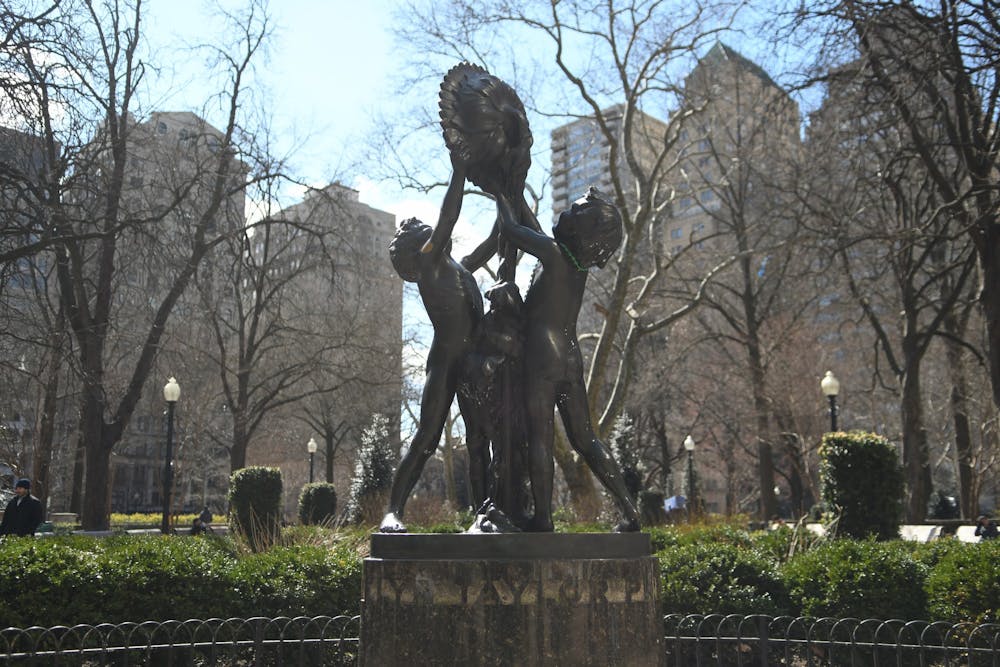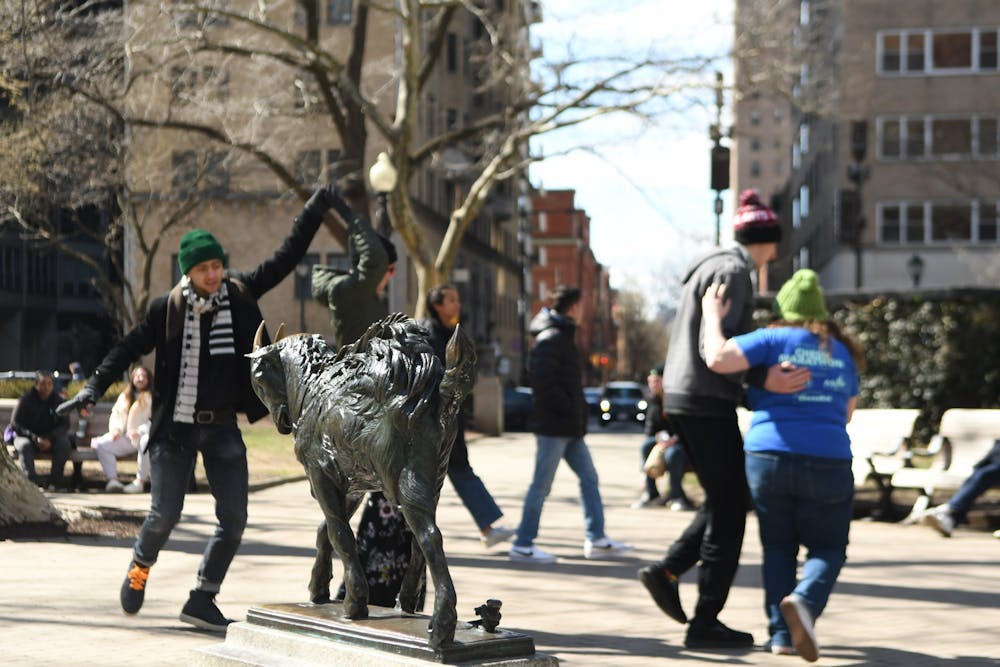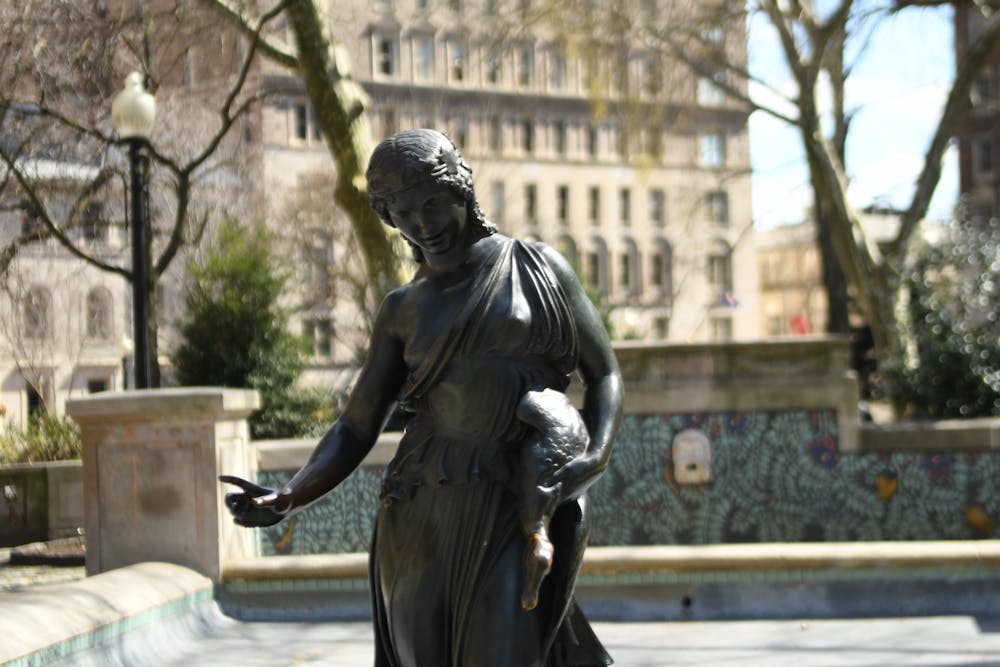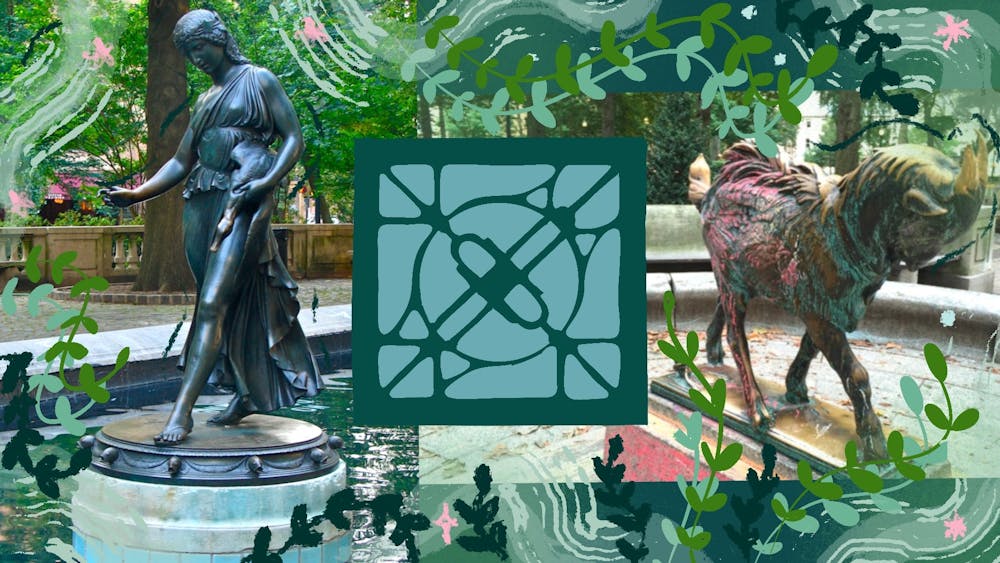It’s 5:30 p.m. on the first 60–degree day in March, and Rittenhouse Square is packed. People just getting off work walk their leashed dogs, ranging from tiny white designer ones to mutts that reach my hip. Parents push strollers as children run around without jackets for the first time in months, while friends sit on benches tagged, “In Memorial Of.” An artist rests with his back against the fence, willing passersby to purchase the paintings that sit alongside him. Another plays the flute.
I’ve walked through Rittenhouse Square innumerable times since my acceptance to Penn, and a few before that. I know stories about the old buildings that overlook the greenery and have a couple of favorite menu items from the fancier restaurants that line the square. I even know the exact spot in it where my grandparents got engaged. But I know nothing, absolutely nothing, about the art within it. And I’m determined to find out.

At the southwest entrance of the park, two sand–colored greyhound sculptures welcome visitors and guard the park. The Association for Public Art (aPA), the authority on caring for and interpreting public art in Philadelphia, tells me that these were donated by friends and family of Henry P. Mcllhenny, a longtime resident and supporter of the square. Mcllhenny was a prominent member of the arts community in Philadelphia, serving the Philadelphia Museum of Art for 50 years first as curator of decorative arts, then as chairman of the Board of Trustees. Apparently, Andy Warhol called him “the only person in Philadelphia with glamor.”
My next stop on this self–guided tour is the Evelyn Taylor Price Memorial Sundial (1947) by Philadelphia native Beatrice Fenton. Next to it is a small plaque with a phone number that says, “Museum Without Walls." After dialing and entering the stop number, I’m greeted with a short audio recording. “Museum Without Walls” is an info series put on by the aPA with four stops throughout Rittenhouse (and many more across the city) that makes knowledge about art in the park more accessible.
The Evelyn Taylor Price Memorial Sundial features two children holding a sunflower between them. The head of the sunflower serves as a working sundial with the inscription, “As the hour passes, friendship abides.” The sculpture was given in memory of Evelyn Taylor Price, who was president of the Rittenhouse Square Improvement Association and the Flower Market Association for more than 20 years. The Flower Market Association was conceived for charity—a way for people to support the square and to promote civic engagement by purchasing flowers.
I stop by the next sculpture I see: Giant Frog (1941) by Cornelia Van Auken Chapin. The frog, about three feet tall, rests peacefully on a rock, enjoying the nice weather. I meet a man named Christian resting with his bulldog, Ziggy, beside it. He tells me this is Ziggy’s favorite sculpture, but he personally likes “Billy the goat.”

In 1914, when Eli Kirke Price II, a prominent Philadelphian and then–president of the Philadelphia Museum of Art, saw Billy at a show by the Pennsylvania Academy of the Fine Arts (PAFA), he decided it would be perfect for the square. Everyone else disagreed. The Fairmount Park Art Association, the precursor to the aPA, called it ugly, too small, and not “majestic” enough. But eventually, they forgot about the sculpture, and four years later, the “stubborn” and “spirited” Price got his way. Today, his great–great–grandchildren appreciate the sculpture, as shown by their imitation of goat noises on the "Museum Without Walls" audio tour.
Perhaps the lack of grandeur that it once was rejected for is what makes it so beautiful. Without a pedestal, Billy meets little ones at their height. I can tell he’s much loved by them—the goat is completely covered in sidewalk chalk, and his horns and back have been rubbed to gold from being petted by tiny hands.
This isn’t the original Billy, however. Like a beloved stuffed animal, the first goat came apart over the years. His metal thinned, making him more vulnerable to the elements. After 99 years of living in the square, in September 2018, the original sculpture was retired and an exact replica took its place.
According to CBS News, to celebrate this transition, the city held a retirement party of sorts, complete with a petting zoo and live music. The original sculpture now lives happily just across the street, in the children's wing of the Free Library of Philadelphia's City Institute branch.
I watch four children in school uniforms jump up and down on the semi–circular bench that surrounds the new Billy, and include him in their game of tag. I know he’s just as loved as his old twin.
Across from Billy sits perhaps the most recognizable piece of art in the square: Duck Girl, standing in the middle of the fountain. Sculpted by Paul Manship, the work features a young girl holding a duck. Like Billy, Duck Girl was also first exhibited at PAFA in 1914, but similarly took a while to find its forever home. It was first installed in Cloverly Park, but was damaged and put into storage at the Belmont Stables in 1956. In 1960, it was rescued by the Rittenhouse Square Improvement Association and found its spot in the fountain.

It’s not yet warm enough for the fountain to work, and the water is still drained. So I watch as it becomes a sort of ball pit—kids run around playing soccer, their balls bouncing back to them every time they hit the walls that are supposed to hold the water in. No wonder the duck’s head has been rubbed so shiny—I watch a few kids pet it.
I meet Karen, a woman with gray hair and red–rimmed glasses, who watches the game taking place inside the fountain. She tells me that she loves art—that her house is full of it—but she doesn’t love the art in Rittenhouse for her usual reasons. She loves it for its history and because the kids love it. “That’s the best art—the kids,” she smiles.
Maybe the art that isn’t guarded by the white walls, gold frames, and prices of admission is the art that introduces creativity to the next generation. Perhaps the most unassuming art—the art that rests between us as we live, work, and play—is the art that impacts us the most.

